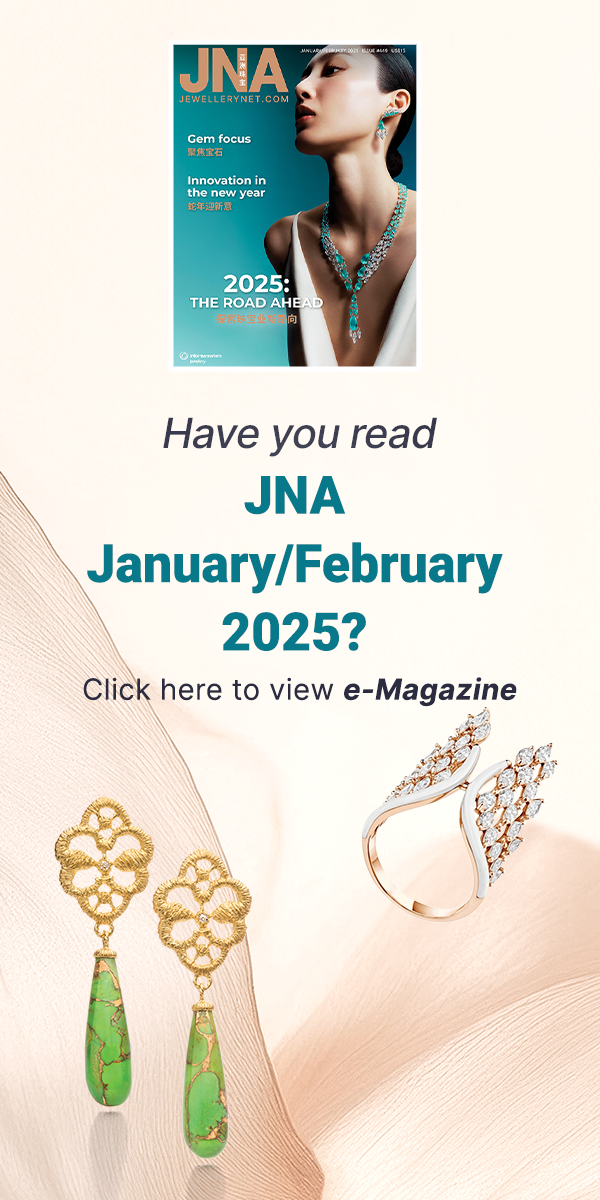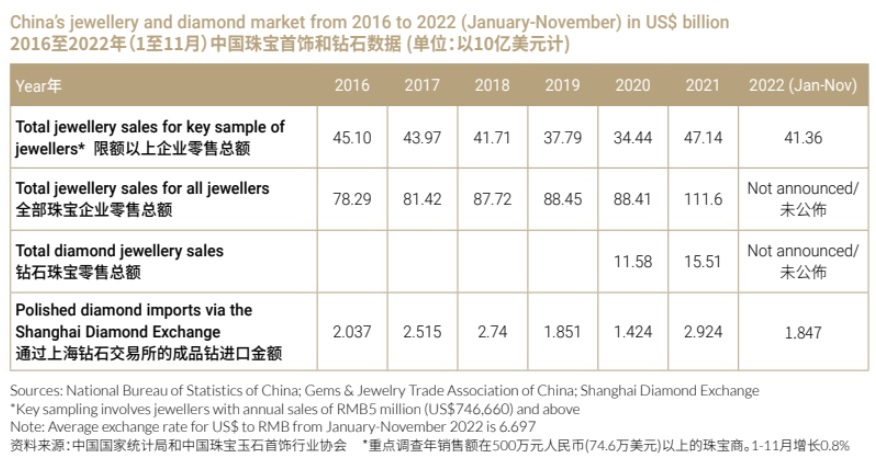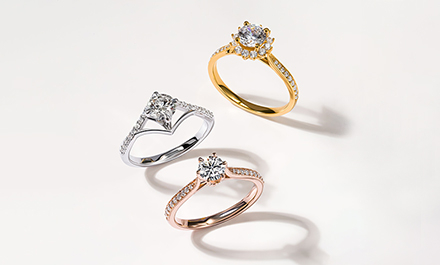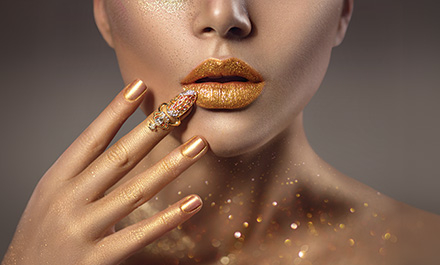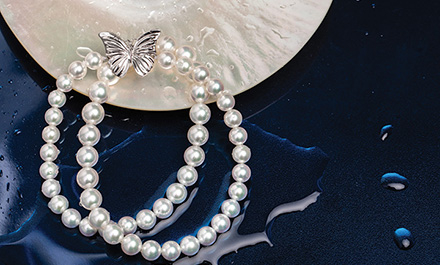China’s diamond market is emerging from pandemic-related downturns, with the trade adapting to new market conditions. Retailers remain invested in omnichannel strategies while jewellers are reaching out to new-generation consumers with niche strategies amid continuing macroeconomic volatility.
This article first appeared in the JNA January/ February 2023 issue.
China’s diamond market is poised to turn the corner in 2023 after its promising comeback amid pandemic challenges was derailed by stringent containment measures last year.
According to The Global Diamond Industry 2021–22 report by Bain & Co, despite the downturn in 2020, key markets grew dramatically in 2021, surpassing 2019 results. Global diamond jewellery retail sales stood at US$84 billion, with the US market reaching US$42 billion and China registering around US$15.5 billion.
In 2022 though, China’s diamond market had to grapple with business pauses and dampened consumer sentiment from sporadic Covid-19 outbreaks and the ensuing curtailment efforts.
Diamond promotions
The Natural Diamond Council (NDC) has been at the forefront of consumer engagement in China. According to its Managing Director for Greater China Mabel Wong McCormick, NDC research indicates that millennial and Gen Z consumers constitute China’s main customer base for diamond jewellery.
Wedding jewellery remains the backbone of the country’s diamond market. As couples in China now tend to marry later in life, they would be more financially independent and may have a higher spending budget, most likely opting for a centre diamond of one carat and above. Self-reward is an even stronger purchase driver, with consumers celebrating important moments by buying themselves diamonds.
NDC’s “push-and-pull” strategy to engage consumers in China includes dedicated content and assets for promotions. These are available as well to its two strategic retail partners, Chow Tai Fook and Zbird. NDC’s content has a daily reach of around 300,000 people in Tier 1 through to Tier 5 cities. Chow Tai Fook stores using NDC content grew from 3,000 in 2021 to around 6,000 in 2022, according to NDC. Zbird, meanwhile, features these in many outdoor locations in Central Business Districts and at airports. NDC intends to strengthen this strategy in 2023 and plans to invite 10 more retailers to avail of its promotional content and assets.
“NDC’s task is to promote an industry, not a brand,” McCormick explained.
In December 2022, NDC teamed up with Vogue China and the country’s top industry experts in fashion and jewellery to launch the 2023 Trend Report that identifies five distinct diamond jewellery trends in China – infinite natural, unlimited faces, imaginable shapes, pure sensations and golden wonders.
The council forecasts that, while the pandemic hindered the development of its diamond market, China could overtake the US as the world’s biggest diamond market as early as 2028.
Golden opportunities
Diamond jewellery is gaining ground in the market, as indicated by its strong showing during the Double 11 shopping festival to celebrate Single’s Day.
Aside from the usual Big 4 favourites – beauty products, fast-moving consumer goods, consumer electronics and apparel, 2022 saw the emergence of New Big 4 categories, namely toys, pet products, jewellery and sports and outdoor products. The popularity of these non-daily essentials attests to consumer trends – shoppers are younger overall, and self-reward purchases to improve quality of life and meet emotional needs are on the rise.
Gold jewellery, traditionally favoured by Chinese consumers, did well during Double 11. JD.com started its promotions on October 20 while Tmall.com followed on October 24. By November 1, sales of gold jewellery on Tmall had grown over 30 per cent year-on-year, with six brands selling over RMB100 million (around US$15 million). MCLON, which carries a wide range of diamond jewellery, reportedly sold over RMB100 million (around US$15 million) worth of gold jewellery in two hours and 21 minutes.
Other diamond jewellery retailers also sold plain gold jewellery during Double 11 to build a future customer base for their diamond products.
Jinghua Jewellery, which has 23 stores in Qingdao, Shandong province, is part of the Jinghua Group, one of the first and shareholding members of the Shanghai Diamond Exchange. According to Jinghua Jewellery General Manager Wu Peng, its strategy for 2022’s Double 11 was to attract more traffic through the trade-in of gold jewellery. “We are also ready to roll out our service to trade-in and upgrade diamonds to further establish our brand. The jewellery industry is often the last to recover after economic turmoil, so we need to be extraordinarily patient,” he said.
Phygital focus
Blue Nile, which has had a presence in China for the last 10 years, is ending its Chinese operations on January 31, 2023. For its part, Zbird, which started as an online diamond retailer, shifted to a phygital model in recent years. It now operates more than 100 showrooms and experience centres in 70 cities across China, combining online sales and offline retail experiences.
For luxury goods, offline stores go beyond sales and serve to establish the brand in the market. “Though online shopping has become mainstream, for high-value products such as diamonds, offline stores serve as both a business channel and the basis for brand communication and customer service,” said Zhang Peiying, an expert on the luxury market in China. He added that strictly online strategies are not feasible for diamond brands and recommended that offline initiatives should take precedence in online-offline models.
De Beers’ Diamond Insight Report 2022 also noted that phygital strategies are a defining feature of the new diamond world, where dedicated and compelling omnichannel strategies are critical. The report revealed that the average online purchase value in China is RMB 7,400 (around US$1,100), compared to an offline average of RMB 9,500 (around US$1,400). This suggests that consumers buying high-value diamonds prefer to view them in person first, but as trust in e-commerce grows, the gap in value may shrink.
Of the consumers who bought diamond jewellery, 26 per cent of Gen Z shoppers first researched on social media – Red or Xiaohongshu, Douyin or Tiktok, WeChat moment or Weibo. In addition, 13 per cent of millennials and 8 per cent of younger millennials aged 24 to 30, looked up their potential purchases on shopping sites such as JD.com, Tmall and Taobao. In contrast, only 2 per cent of Gen Z shoppers checked out these e-commerce sites.
Mega chains have also adopted the online-offline business model. Chow Tai Fook works with as many as 110 online platforms while operating 6,812 stores in mainland China.
Branded and patented
Branding plays a vital role in diamond jewellery sales in China. Most retailers carry their own brand, and sophisticated diamond jewellers even operate multiple sub-brands for their patented diamonds to cater to different customer segments.
Shining House, a diamond jewellery retailer with around 500 stores in the country, relies on its distinctive diamond cuts to strengthen and distinguish its brand in the market.
After the success of ROSACE, its patented and branded round cut with the most number of facets in round brilliant diamonds, the retail chain launched a new generation of patented octagonal diamonds, the Shining Star. The cut achieves a very high level of brilliance, sparkle, fire and light symmetry at the EX level, and has a special "4C+4EX" three-dimensional fire grading report from the International Gemological Institute (IGI).
Shining House Chairman Winny Chun said, “The eight sides of the diamond represent courage, affection, commitment, forgiveness, responsibility, trust, eternity and gratitude, which embody the virtues favoured by different people.”
More than a diamond cut, Shining Star is a business strategy that targets the high-end market. The product line has earned over US$15 million in annual revenue for one of the company’s flagship stores in Guangzhou. Over 200,000 customers have signed up with its Time Bank, a service for customers to express their commitment to loved ones.
Looking forward
While the trade is cautiously optimistic on business prospects in 2023, the performance of the country’s diamond market will depend primarily on the strength of economic recovery following the lifting of pandemic restrictions that had been in place for three years. Business may dip in the early months of 2023 since Covid-19 cases may rise as the country reopens. Diamond retail sales may not benefit from the Chinese New Year retail season, which falls in January this year, but an upturn is expected in spring.
The Luxury Goods Worldwide Market Study released by Bain & Co and Altagamma Luxury Study in November 2022 stated, “China itself, which remains crucial to the long-term growth of the luxury market, continues to confront a challenging phase due to Covid lockdowns and is still performing below 2021 figures. China’s luxury market is expected to recover between H1 and H2 2023.” The report also revealed that mid- and high-income consumers in China increased by 180 million from 2014 to 2022.
Before the pandemic, China’s jewellery market saw great strides in omnichannel sales, customisation, e-commerce and inventory management optimisation. Companies that survived the Covid-19 pandemic have adapted to the new normal. This year, most of China’s diamond jewellers intend to finetune their operations and engage the new generation of consumers.
According to De Beers’ Diamond Insight Report 2022, diamond consumers in China are aged 18 to 54. Gen Z accounts for 10 per cent of the population and 5 per cent of diamond acquisitions, both by volume and value. Its contribution will however increase significantly in the coming years as this generation tends to be self-expressive, competitive and optimistic. Since they value entrepreneurship, they are more likely than other consumers to view diamonds as a mark of success. It is thus essential to capture the hearts and minds of younger consumers, who represent the next major cohort of diamond buyers in China, the report said.


